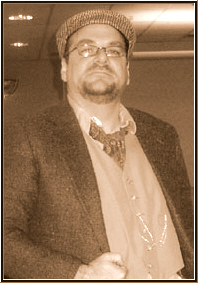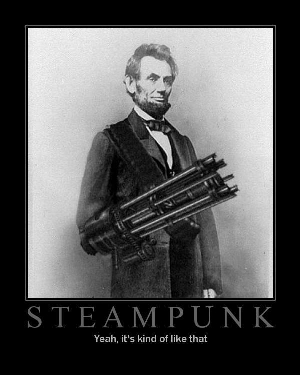 It’s the most pervasive subculture you’ve probably never heard of, firmly established as a literary genre, a fashion aesthetic, even a musical style. It’s getting bigger every day. And its roots go much deeper than even its adherents likely know.
It’s the most pervasive subculture you’ve probably never heard of, firmly established as a literary genre, a fashion aesthetic, even a musical style. It’s getting bigger every day. And its roots go much deeper than even its adherents likely know.
It’s called Steampunk, and you might think of it as an embracing of a world that never was. It idealizes the gas-lamps, the clockwork, and yes, the steam-engines of the late Victorian era…adding in a healthy dose of What if…? What if the Victorians had mastered flight (even space flight)? What if Charles Babbage’s “Differential Engine” had introduced clockwork-driven computing to the late nineteenth century? And what if any number of sci-fi or fantasy elements showed up during the early Industrial Revolution? How might that staid world of tweed, corsets and impeccable manners be impacted?
The Steampunks know. Or at least, they’ve hazarded all sorts of guesses. Attend a Steampunk convention or concert and you’ll see speculation in the form  of costumes and accoutrements: silk waistcoats accented with brass rayguns, gowns and parasols offset with gears, pulleys and steam-valves. As is true with their close cultural cousins, the Cyberpunks, it seems as if dressing up is half the fun.
of costumes and accoutrements: silk waistcoats accented with brass rayguns, gowns and parasols offset with gears, pulleys and steam-valves. As is true with their close cultural cousins, the Cyberpunks, it seems as if dressing up is half the fun.
But unlike Cyberpunk, which was ushered in with the digital revolution, Steampunk has a vene rable origin story indeed. The word itself seems to have been coined in the late eighties, by author K. W. Jeter, as an attempt to categorize the handful of authors (including himself) who were creating sci-fi and fantasy with a Victorian setting. And although it’s true that the genre was innovative for its time, it’s now generally recognized that the Steampunk pioneers were rediscovering trails rather than blazing them.
rable origin story indeed. The word itself seems to have been coined in the late eighties, by author K. W. Jeter, as an attempt to categorize the handful of authors (including himself) who were creating sci-fi and fantasy with a Victorian setting. And although it’s true that the genre was innovative for its time, it’s now generally recognized that the Steampunk pioneers were rediscovering trails rather than blazing them.
After all–what could be more Steampunk than a group of gentlemen, in the 1870s, riding a capsule fired from an immense gun, all the way to the moon? Or a Victorian inventor crafting a brasswork time machine in his parlor? That both of these scenarios spring from nineteenth-century novels by Jules Verne and H.G. Wells, respectively, gives a lengthy literary pedigree to what is now an undeniable cultural phenomenon.
Because Steampunk has moved way beyond the printed page. Verne and Wells were popular, even influential in their day. But they could have never foreseen their speculative fiction influencing music, art and design the way Steampunk is doing now.
Steampunk music, in particular, represents an aesthetic immersion. Bands like Abney Park, Voltaire and Rasputina present audiovisual spectacles, steeped in Steampunk, that extend to the design of their instruments, the construction of their stage-sets, even the narrative of their backstories. Abney Park, for example, style themselves as a crew of drunken airship pirates, fighting and plundering their way across a not-quite familiar Victorian landscape. It’s a compelling image–made all the more appealing by the fact that the music is really quite good.
Those visual elements, early industrial machinery reimagined in fantastical ways, underpin the  entire Steampunk universe. Even the modern literary genre depends heavily on that descriptive aesthetic, undoubtedly because the fans demand it. And the fans adopt it themselves; not only in the aforementioned costuming but also in the pervasive practice of “modding”: modifying practically any modern object with a Steampunk appearance.
entire Steampunk universe. Even the modern literary genre depends heavily on that descriptive aesthetic, undoubtedly because the fans demand it. And the fans adopt it themselves; not only in the aforementioned costuming but also in the pervasive practice of “modding”: modifying practically any modern object with a Steampunk appearance.
And that hands-on appeal, that invitation to bring Steampunk fully into one’s life, might just guarantee its lasting success. It is attracting the tinkerers, the artists and the writers who are investing themselves for the long haul. They’re building whole worlds around it.
And so what if it’s a world that never was? Speculation of what could have been is one of the few things that can unite literature, music and visual art. In the case of Steampunk, it is uniting them in reverence to a simpler, classier, more refined time. And many would argue that in our twisted, early twenty-first century reality, looking backwards is a hell of a lot cheerier than looking ahead.

There is apparently a lot for me to ascertain outside of my books. Thanks for the great read